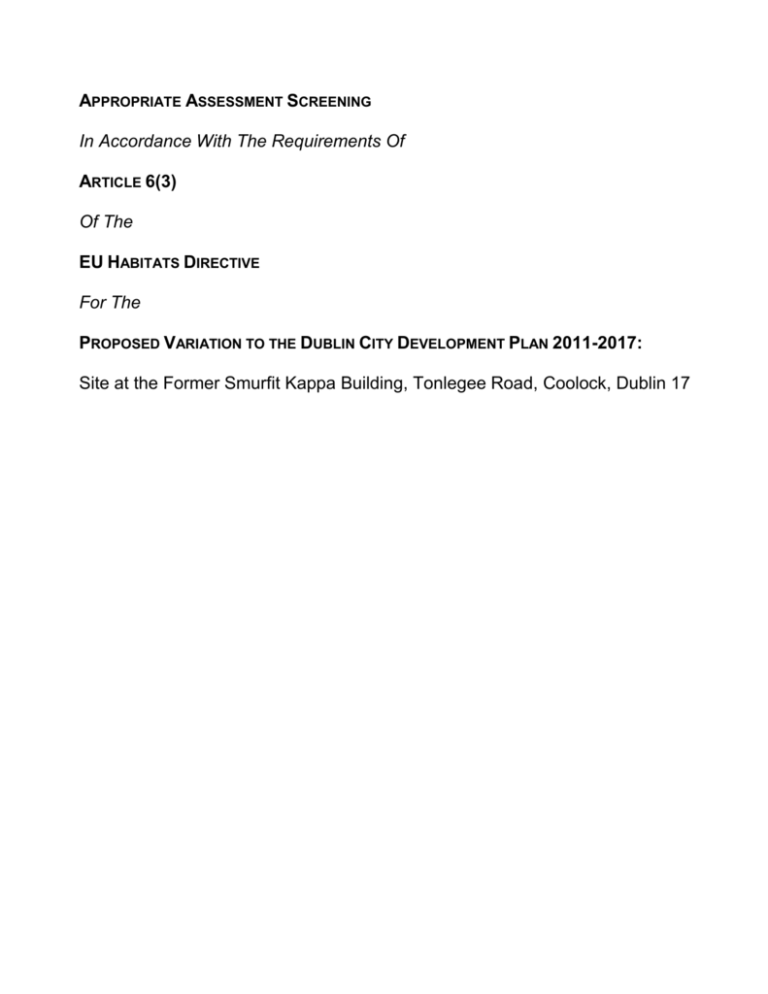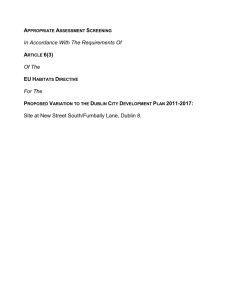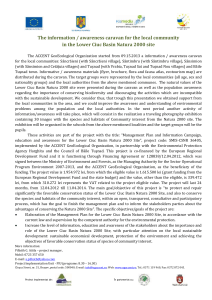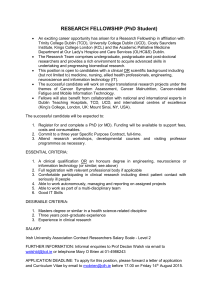AAScreening Smurfit Factory Coolock
advertisement

APPROPRIATE ASSESSMENT SCREENING In Accordance With The Requirements Of ARTICLE 6(3) Of The EU HABITATS DIRECTIVE For The PROPOSED VARIATION TO THE DUBLIN CITY DEVELOPMENT PLAN 2011-2017: Site at the Former Smurfit Kappa Building, Tonlegee Road, Coolock, Dublin 17 SECTION 1 – INTRODUCTION & TERMS OF REFERENCE This is an Appropriate Assessment Screening of the proposed variation of the Dublin City Development Plan in relation to a site at the former Smurfit Kappa Building, Tonlegee Road, Coolock, Dublin 17, in accordance with the requirements of Article 6(3) of the EU Habitats Directive (92/43/EEC). The proposed variation will change the zoning From Zoning Objective Z6 – To provide for the creation and protection of enterprise and facilitate opportunities for employment creation. To Zoning Objective Z1 – To protect, provide and improve residential amenities. The proposed variation has been assessed to ascertain if it is required to be subject to an ‘Appropriate Assessment’ under the EU Habitats Directive. Based on the ‘Methodological guidance on the provision of Article 6(3) and (4) of the Habitats Directive 92/43/EEC, a ‘Screening Matrix’ and a ‘Finding of No Significant Effects Matrix’ have been completed. The principal trigger for undertaking an ‘Appropriate Assessment’ would be if the proposed variation was likely to have significant effects on a Natura 2000 site. For the purposes of Article 6 assessments, Natura 2000 sites are those identified as Sites of Community Importance under the Habitats Directive (normally called Special Areas of Conservation) or classified as Special Protection Areas under the Birds Directive (79/409/EEC). There are no Natura 2000 sites in the proposed variation area. The nearest Natura 2000 site is in the order of approx 2.6 kilometers to the east of the Local Area Plan boundary within Dublin Bay. The Natura 2000 sites within the wider vicinity of the variation area and within the Dublin region are as follows: 1. North Dublin Bay cSAC (IE000206) 2. South Dublin Bay cSAC (IE000210) 3. North Bull Island SPA (IE00406) 4. South Dublin Bay & River Tolka Estuary SPA (IE004024) 5. Howth Head Coast SPA (IE004113) 6. Baldoyle Bay SPA (IE004116) 7. Baldoyle Bay cSAC (IE000199) 8. Howth Head cSAC (IE000202) Irelands Eye cSAC (IE002193) 9. Irelands Eye SPA (IE004117) 10. Malahide Estuary cSAC (IE000205) 11. Malahide Estuary SPA (IE004025) 12. Glenasmole Valley cSAC (IE001209) 13. Wicklow Mountains cSAC (IE002122) Dalkey Island SPA (IE004172) 14. Rockabill to Dalkey Islands cSAC (IE003000) Circular Letter SEA 1/08 & NPWS 1/08 issued by the Department of Environment, Heritage and Local Government requires that, as a result of European Court of Justice Case 418/04 EC Commission v Ireland, any draft land use plan (or amendments or variations) proposed under the Planning & Development Act 2000 (as amended) must be screened for any potential impact on areas designated as Natura 2000 sites. The results of the screening should be recorded and made available to the public. It should be noted that a Strategic Environmental Assessment Screening Report has been prepared for the proposed variation Figure 1 below illustrates all of the designated sites in the wider vicinity of the Coolock area. Proposal: It is proposed to vary the Dublin City Development Plan 2011-2017 by changing the zoning to the site at the former Smurfit Kappa Building, Tonlegee Road, Coolock, Dublin 17 From Zoning Objective Z6 – To provide for the creation and protection of enterprise and facilitate opportunities for employment creation. To Zoning Objective Z1 – To protect, provide and improve residential amenities. Site Description: The subject site incorporates a large industrial building, with employee car parking provided on site. The site area is approx. 2.073ha and is directly accessed via Tonlegee Road to the south. The Malahide Road is located to the west and incorporates a Quality Bus Corridor. An adjoining housing estate incorporating Rathvale Drive, Ayrfield Road and Ayrfield Drive is directly to the north and east, and an adjoining Z4 District Centre, including leisureplex, retail units and car parking facilities, is located immediately to the east. The subject site is currently unoccupied and is closed off from public viewing. St John the Evangelist Church and church hall, located immediately to the south, is designated in the Dublin City Development Plan as Z9 Amenity/Open Space Lands/Green Network and is also an area of architectural interest. There is no direct link between the subject site and the adjoining Z1 Residential or Z4 District Centre lands. Purpose of Proposed Variation: The site currently has a Z6 zoning, ‘to provide for the creation and protection of enterprise and facilitate opportunities for employment creation’. The proposed rezoning will complement the adjoining Z1 land use designation and represents a consolidation of surrounding residential lands. In addition, taking into account the previous industrial use of the lands, together with the pedestrian and vehicular traffic the former Smurfit factory would have generated; the proposed variation is unlikely to have any greater impact on the residential amenity of nearby residents. The established entrance onto the Tonlegee Road and close proximity to the Malahide Quality Bus Corridor (QBC) ensures a change to a residential zoning is unlikely to detrimentally impact on the circulation of traffic in the local vicinity. The subject site is currently unoccupied, does not presently contribute to employment or enterprise within the city, and represents an isolated and relatively constrained plot size in comparison to larger areas of Z7 Employment (Industry) lands to the east and north east along Malahide Road such as Coolock Industrial Estate or the Cadbury Factory. Taking this into consideration, if rezoned to Z1, the lands are unlikely to negatively impact on the Dublin’s strategic land bank of Z6 zoned lands or negatively impinge in the present or future development of nearby Z7 lands Taking cognisance of the above, the proposed variation to the site at the former Smurfit Kappa Building from Z6 Employment/Enterprise Zone to Z1 Residential, is unlikely to have a detrimental impact on the subject site or the surrounding area. The proposed rezoning will complement the adjoining Z1 land use designation and will provide an opportunity to redevelop a vacant and underutilized brownfield site. SECTION 2.0 - SCREENING MATRIX Brief Description of Project or Plan The proposed variation of the Dublin City Development Plan is to change the zoning (2.073ha) of the site at the former Smurfit Kappa Building from Z6 Employment/Enterprise Zone to Z1 Residential. The subject site is currently vacant, does not presently contribute to employment or enterprise within the city and a rezoning to Z1 Neighbourhood Centre is unlikely to have a detrimental impact on the subject site or the surrounding area. The proposed rezoning will complement the adjoining Z1 land use designation and will provide an opportunity to redevelop a vacant and underutilized Brownfield site. Brief description of the Natura 2000 sites The proposed variation area does not include any Natura 2000 sites within its boundary. As referred to in Section 1 above, a number of designated Natura 2000 sites are located in the wider vicinity of the Coolock area, albeit at a considerable distance. The closest Natura 2000 sites are located within Dublin Bay and include a wide variety of inter-tidal, marine and coastal zoned habitats supporting a range of species including Annex 1 bird species. Assessment Criteria Describe any likely direct, indirect or secondary impacts of the project (either alone or in combination with other plans or projects) on the Natura 2000 site by virtue of: There is no Natura 2000 site in the proposed variation area. There are no likely direct impacts on any Natura 2000 sites as a result of the proposed variation. Size and scale; The proposed variation consists of a (2.073ha) site of land currently zoned Z6 Employment/Enterprise Zone in an established urban area. Any future new development will be integrated into the established urban pattern and is not predicted to have any likely impact on the conservation function of any Natura 2000 site in respect to size or scale. Land-take; Not applicable Distance from Natura 2000 site or key features of the site; The nearest Natura 2000 site is in the order of approx 2.6km distant from the proposed variation area within Dublin Bay. The proposed variation is not predicted to have any likely impact on the key features or the conservation function of any Natura 2000 sites. Resource requirements (water abstraction etc); Resource supply, including potable water, will be provided from existing municipal infrastructure. Any potential indirect or secondary impact on the conservation function of any Natura 2000 site as a result of increased population equivalent (P.E) demand for potable water supply will be subject to a separate higher level Appropriate Assessment/Strategic Environmental Assessment (SEA) at regional level. Emission (disposal to land, water or air); No predicted likely direct impact on the conservation function of any Natura 2000 site is predicted as a result of the implementation of the proposed variation. The most likely potential indirect or secondary impact on a Natura 2000 site is by way of effluent discharge from the Ringsend waste water treatment plant which serves the entire Dublin region to Dublin Bay. Any future planning permission will be subject to conditions to ensure disposal to land, water and air has no impact on any Natura 2000 site. The provision of adequate waste water treatment capacity is a regional issue which is being addressed by way of the Greater Dublin Strategic Drainage Study (GDSDS) and accompanying SEA. The GDSDS identifies population numbers for the region and sets out a capital investment programme for the delivery of major drainage infrastructure provision. The capital investment programme includes provision for the Ringsend Treatment Plant Upgrade and a 22km Orbital Sewer for a new North County Treatment Plant. This issue will also be addressed within the context of the forthcoming review of the Dublin City Development Plan. Excavation requirements; Not Applicable. Transportation requirements; Not Applicable. Duration of construction, operation, decommissioning, etc; Not Applicable. Other None Describe any likely changes to the site arising as a result of: Reduction of habitat area: Not applicable Disturbance to key species; Not Applicable Habitat or species fragmentation; Not applicable Reduction in species density; Not Applicable Changes in key indicators of conservation value Not Applicable Climate change: Not Applicable Describe any likely impacts on the Natura 2000 site as a whole in terms of: Interference with the key relationships that define the structure of the site; No predicted likely impact on the conservation function of any Natura 2000 sites. Interference with key relationships that define the function of the site; No predicted likely impact on the conservation function of any Natura 2000 sites. Provide indicators of significance as a result of the identification of effects set out above in terms of: Loss; Not applicable Fragmentation; Not applicable. Disruption; Not applicable. Disturbance; Not applicable. Change to key elements of the site (e.g. water quality etc); Not applicable Describe from the above those elements of the project or plan, or combination of elements, where the above impacts are likely to be significant or where the scale or magnitude of impacts are not known. No predicted likely impact on the conservation function of any Natura 2000 sites. SECTION 3.0: FINDING OF NO SIGNIFICANT EFFECTS M ATRIX Name of Project or Plan: Proposed Variation of Dublin City Development Plan 2011 2017 to site at the Former Smurfit Kappa Building, Tonlegee Road, Coolock, Dublin 17. Name and location of Natura 2000 sites: No Natura 2000 sites are located in the proposed variation area. Natura 2000 sites in the wider vicinity of the proposed variation area are provided in Section 1 above. Description of the Project or Plan As provided in the screening matrix above. Is the Project or Plan directly connected with or necessary to the management of the site (provide details)? No. Are there other projects or plans that together with the project or plan being assessed could affect the site (provide details)? The draft variation provides for the sustainable development to a circa 2.073ha of land in accordance with the Dublin City Development Plan 2011-2017 and the principles of proper planning and development. It is not predicted that that the zoning variation will have any impact on the conservation function of any Natura 2000 site. The Assessment of Significance of Effects Describe how the project or plan (alone or in combination) is likely to affect the Natura 2000 sites: No predicted likely impact on the conservation function of any Natura 2000 sites. Explain why these effects considered significant: The draft variation provides for the sustainable development to a circa 2.073ha of land in accordance with the Dublin City Development Plan 2011-2017 and the principles of proper planning and development. are not It is not predicted that that the zoning variation will have any impact on the conservation function of any Natura 2000 site. List of Agencies Consulted: Provide contact name and telephone or email address: Response to Consultation Data Collected to Carry out the Assessment Who carried out the Assessment? Planning and Economic Development Department Dublin City Council Sources of Data Existing Data Level of Assessment Completed Desktop Study Where can the full results of assessment be accessed and viewed Overall Conclusion the This document contains the full results of the Appropriate Assessment Screening exercise and will be placed on display with the proposed variation. The proposed variation does not significantly alter any policy or objective of the development plan However, in line with the precautionary principle, it is considered appropriate to undertake an appropriate assessment screening as the proposal forms part of the Dublin City Development Plan 2011 – 2017. Stage 1 screening indicates that the proposed variation will not have any significant cumulative, direct or indirect impacts upon any of the Natura 2000 sites. Therefore it is not considered necessary to undertake any further stages of the Appropriate Assessment process.







